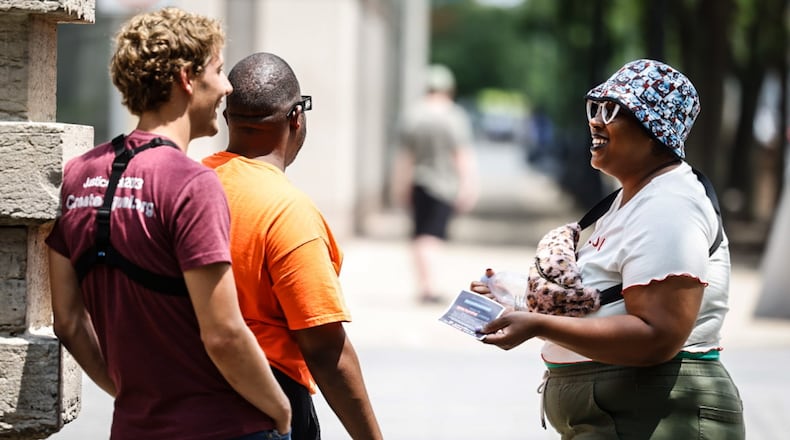“I feel fairly confident that yeah, if we get that done, we’ll win in November,” Harrington said.
Since its inception in the legislature earlier this year, Issue 1 has been criticized by opponents for its timing. The irregular August election, set by lawmakers just months after they eliminated nearly all August elections due to high costs and low voter turnout, has been seen by opponents as a way to rig the game three months before Ohioans will possibly have the chance to vote on abortion access this November.
While Issue 1′s support is broader than just anti-abortion organizations — including the Ohio Chamber of Commerce, the National Federation of Independent Business, the Ohio Pork Council and the Ohio Farm Bureau — Harrington said his group’s support is hinged on abortion.
“For us, it’s about abortion, as you know,” Harrington said. “Our pitch is: The Constitution of Ohio should be difficult to change. It’s not a policy document, it’s a legal framework to govern the state, protect freedoms, those kinds of things.”
Harrington told the Dayton Daily News that, now that Roe v. Wade is overturned, state’s abortion laws should be decided by that state’s lawmakers, not through the citizen-initiated constitutional amendment process.
“It’s been a long time. Now it’s back to the people where it should be,” Harrington said. “We’ve got a battle on our hands, it’s going to be state by state by state, but it should be done through the legislature and not through the constitutional amendment process.”
Harrington said a majority vote in November on the abortion-rights amendment would “maybe” be a fair indicator of the state’s stance on abortion, but that statewide votes on public issues as tightly contested as abortion can be easily swayed by campaigns backed by big money.
“It’s easy for outside money and special interests to come into a state and basically buy an election, right, and we’re outgunned every year when it comes to these kinds of constitutional amendments,” Harrington said. “That’s why I believe that something like this shouldn’t be a 50% + 1, because it’s not hard to win a 50% +1 election, it just isn’t. You can move some numbers easily if you control the airwaves and the earned media and so, we know that we will be outspent more than likely in these issues.
In Ohio, recent polls have indicated that a majority under 60% support protecting access to abortions. A Baldwin Wallace University “Ohio Pulse” poll from October 2022 showed 59.1% of respondents in favor of enshrining abortion protections in the Ohio constitution; a June 2023 Scripps News / YouGov poll showed 58% of respondents in support of protecting “protect an individual’s right to make their own decisions about issues like abortion, contraception and fertility treatment.”
Harrington contends that, despite the polling, the abortion-rights amendment that will likely be on the November ballot is out of step with Ohioans’ general opinion on abortion — but conceded that most people do support abortion access within the first trimester, or 12 weeks, of a pregnancy.
The November abortion-rights amendment would protect abortion access for any reason up to fetal viability, about 24 weeks into pregnancy, but allows the Ohio legislature to ban abortions thereafter except in cases of severe health risk to the mother.
Harrington noted that supporting Issue 1 could potentially put anti-abortion groups at a disadvantage if both Issue 1 and the November abortion-rights amendment were to pass — or if the state legislature were to change its tune on abortion in the future. In either scenario, anti-abortion organizations could look to amend the constitution in order to enact favorable policy.
“Will we ever get around to try pass a constitutional amendment? Probably,” Harrington said. “But we understand that there’s a double edged sword here, too. If we raise it to 60, it’s going to make it harder for us as well — but we’re playing defense right now. We’re trying to stop bad things from happening, these types of one-size-fits-all, fell-swoop (abortion-rights amendments).”
About the Author

